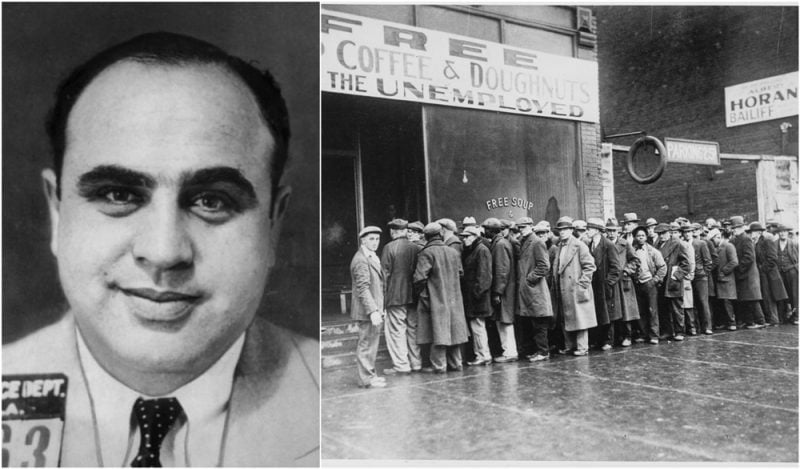Soup kitchens first appeared in America around 1929, as the effects of a growing depression became apparent. When the economy fell into a tailspin in 1932, 12 million Americans, roughly 25% of the average labor force, were out of work, and the need for soup kitchens became even more acute. But did you know who was the first person to open a soup kitchen during the Great Depression?
During the Great Depression, Al Capone was the first person to open a soup kitchen to feed the poor. At a time when unemployment was at 25%, Capone’s kitchens served three meals a day to ensure that everyone who had lost a job could eat. Soon, every city and town had a soup kitchen.
Al Capone, the Philanthropist Mobster
Four years after taking over Chicago’s leading crime syndicate, gangster Al Capone had amassed over $40 million, roughly $550 million today. During Prohibition, the money came from illegally selling alcohol; bottles were distributed to over 10,000 speakeasies and brothels in a vast bootlegging network across the Midwest.
Capone’s alcohol distribution was illegal, but many Americans considered him a hero. He claimed to be just a businessman giving the people what they wanted, and they wanted liquor more than anything else in the 1920s.
However, Capone’s role as an Italian-American Robin Hood did not end there. While orchestrating criminal activities behind the scenes, Capone launched a program to provide milk to Chicago schoolchildren and made large donations to local charities.
However, the stock market crash on October 29, 1929, inspired Capone to do his greatest charitable work. The American economy collapsed into the Great Depression almost overnight. Banks failed, businesses closed, and millions became unemployed and hungry. Hundreds of soup kitchens have sprouted up across the country. Al Capone owned one of them. (Source: Mental Floss)
The Mob Soup Kitchen
When Al Capone’s soup kitchen opened in mid-November 1930 at 935 South State Street in Chicago’s South Loop neighborhood, hundreds of thousands of Chicagoans were out of work. By the following year, 624,000 people, or half of Chicago’s workforce, were out of work.
Capone’s charity had no name; it simply advertised Free Soup, Coffee, and Doughnuts for the Unemployed. Inside, women in white aprons served an average of 2200 people daily with a smile and no questions asked.
Capone’s efforts to feed Chicago during the Great Depression were not entirely selfless. It was the idea of his friend and political ally, Daniel Serritella, who was elected to the Illinois state senate in 1930. Capone also did not put much of his own money into the operation. Instead, he bribed and extorted other businesses to stock the pantry, according to Deirdre Bair in Capone: His Life, Legacy, and Legend.
In one case, during Seritella’s 1932 trial for conspiring with grocers to defraud customers, the court discovered that a load of ducks intended for Christmas baskets for the poor ended up in Capone’s soup kitchen.
Perhaps more than anything else, Capone opened his soup kitchen to win back the public’s support after being implicated in the 1929 Saint Valentine’s Day Massacre. Capone’s associates were believed to have assassinated seven men, five of whom were members of the rival North Side Gang, inside a Chicago parking garage during that murder spree, though no one was ever prosecuted. Mary Borden, a Harper’s writer, summed up Capone’s double-dealing when she described him as an ambidextrous giant who kills with one hand and feeds with the other. (Source: Mental Floss)
Image from TheVintageNews
